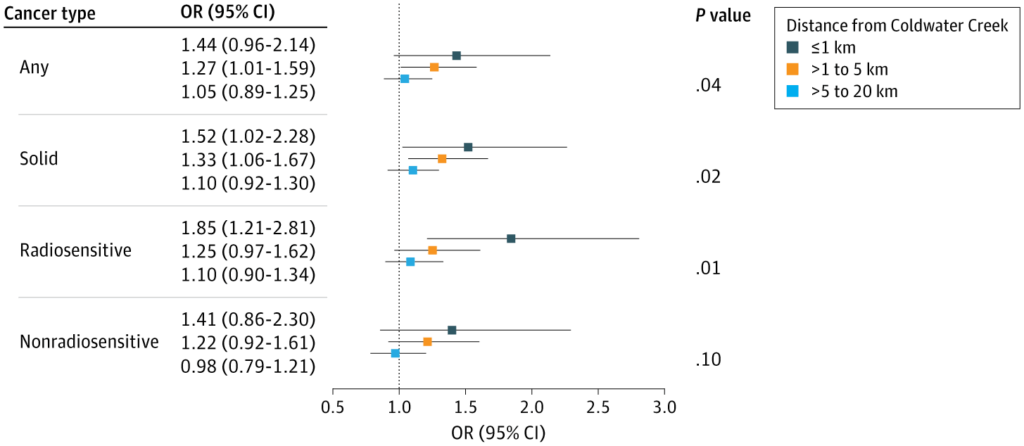Cancer Incidence and Childhood Residence Near the Coldwater Creek Radioactive Waste Site
Article link: https://jamanetwork.com/journals/jamanetworkopen/fullarticle/2836420?guestAccessKey=419fa756-ba1e-4ae9-b3f0-283e93f440bb&utm_source=for_the_media&utm_medium=referral&utm_campaign=ftm_links&utm_content=tfl&utm_term=071625
Reference: Leung, M., Tang, I. W., Lin, J. J. Y., Mucci, L., Farmer, J. G., McAlaine, K., Mangano, J. J., & Weisskopf, M. G. (2025). Cancer Incidence and Childhood Residence Near the Coldwater Creek Radioactive Waste Site. JAMA Network Open, 8(7), e2521926. doi:10.1001/jamanetworkopen.2025.21926
Study question: Does growing up near Coldwater Creek during the time it was contaminated with radioactive waste increase the risk of getting cancer later in life?
Our recently published study demonstrates that children who grew up near Coldwater Creek in the 1940s-60s have an increased risk of developing cancer. Using data from participants from the St. Louis Baby Tooth—Later Life Health Study (SLBT), we showed that the closer participants lived in childhood to Coldwater Creek, a Missouri River tributary north of St. Louis, the more likely they have been to develop cancer over their life. Out of a subsample of 4,209 SLBT participants (now at an average age of 63), 1,009 self-reported having cancer. Of those, the proportion reporting cancer was higher the closer they lived to the creek—30% lived less than one kilometer away, 28% between one and five kilometers away, 25% between five and 20 kilometers away, and 24% lived 20 kilometers or more away.
Compared to those who lived 20 kilometers or more away from Coldwater Creek, those who lived less than one kilometer away have:
- a 44% higher risk of developing any type of cancer
- a 52% higher risk of developing a solid cancer (cancers that form a mass, as opposed to blood cancers)
- an 85% higher risk of developing radiosensitive cancers (thyroid, breast, leukemia, and basal cell skin cancer)
- and a 41% higher risk of developing non-radiosensitive cancers (all except thyroid, breast, leukemia, and basal cell skin cancer)
The results for these different groups and different childhood residential distances from Coldwater Creek are shown in the figure below.
Figure: Estimates for the Association Between Composite Cancer Outcomes and Proximity to Coldwater Creek * An odds ratio (OR) is a measure of association between an exposure and an outcome. It represents the odds that an outcome will occur given a particular exposure, compared to the odds of the outcome occurring in the reference group (participants with childhood addresses >20 km from Coldwater Creek). This figure shows that participants living closer to Coldwater Creek had a higher chance of developing cancer, especially radiation sensitive cancers, compared to those living >20 km away.” |
Under the Manhattan Project, uranium was refined in St. Louis, Missouri for the development of the first atomic bomb. Radioactive waste generated from this process leached into local waterways, including Coldwater Creek. Residents have long been concerned about the health risks, particularly excess cancers, from radiological contamination from Coldwater Creek.
This paper has generated a lot of interest in the media as it comes on the heels of Congress passing an expanded version of the Radiation Exposure Compensation Act (RECA), which now includes the historically overlooked St. Louis-area residents. The measure provides financial compensation and health screenings for those exposed to radiation resulting from the federal government’s handling of radioactive waste in North St. Louis County. See below for links to recent news stories on our study.
- Article
“Cancer Incidence and Childhood Residence Near the Coldwater Creek Radioactive Waste Site,” by Michael Leung, Ian W. Tang, Joyce J.Y. Lin, Lorelei Mucci, Justin G. Farmer, Kaleigh McAlaine, Joseph J. Mangano, and Marc. G. Weisskopf, JAMA Network Open, July 16, 2025, doi: 10.1001/jamanetworkopen.2025.21926 - Harvard T.H. Chan School of Public Health press release
https://hsph.harvard.edu/news/living-near-st-louis-area-coldwater-creek-during-childhood-linked-with-higher-risk-of-cancer-from-radiation/ - First Alert 4
https://www.firstalert4.com/video/2025/07/16/historic-baby-teeth-show-increased-risk-childhood-cancer-near-coldwater-creek-harvard-study-cla/ - Newsweek
https://www.newsweek.com/atomic-waste-kids-us-cancer-risk-2099626 - NPR
https://www.npr.org/sections/shots-health-news/2025/07/21/nx-s1-5474883/nuclear-waste-manhattan-project-missouri-reca-jama - St. Louis Public Radio
https://www.stlpr.org/health-science-environment/2025-07-16/st-louis-coldwater-creek-study-cancer-risk-higher - US News and World Report
https://www.usnews.com/news/health-news/articles/2025-07-17/living-near-polluted-missouri-creek-as-a-child-tied-to-later-cancer-risk - Wall Street Journal
https://www.wsj.com/health/healthcare/st-louis-manhattan-project-cancer-risk-b7d3e9dd?st=4LsnGW&reflink=desktopwebshare_permalink